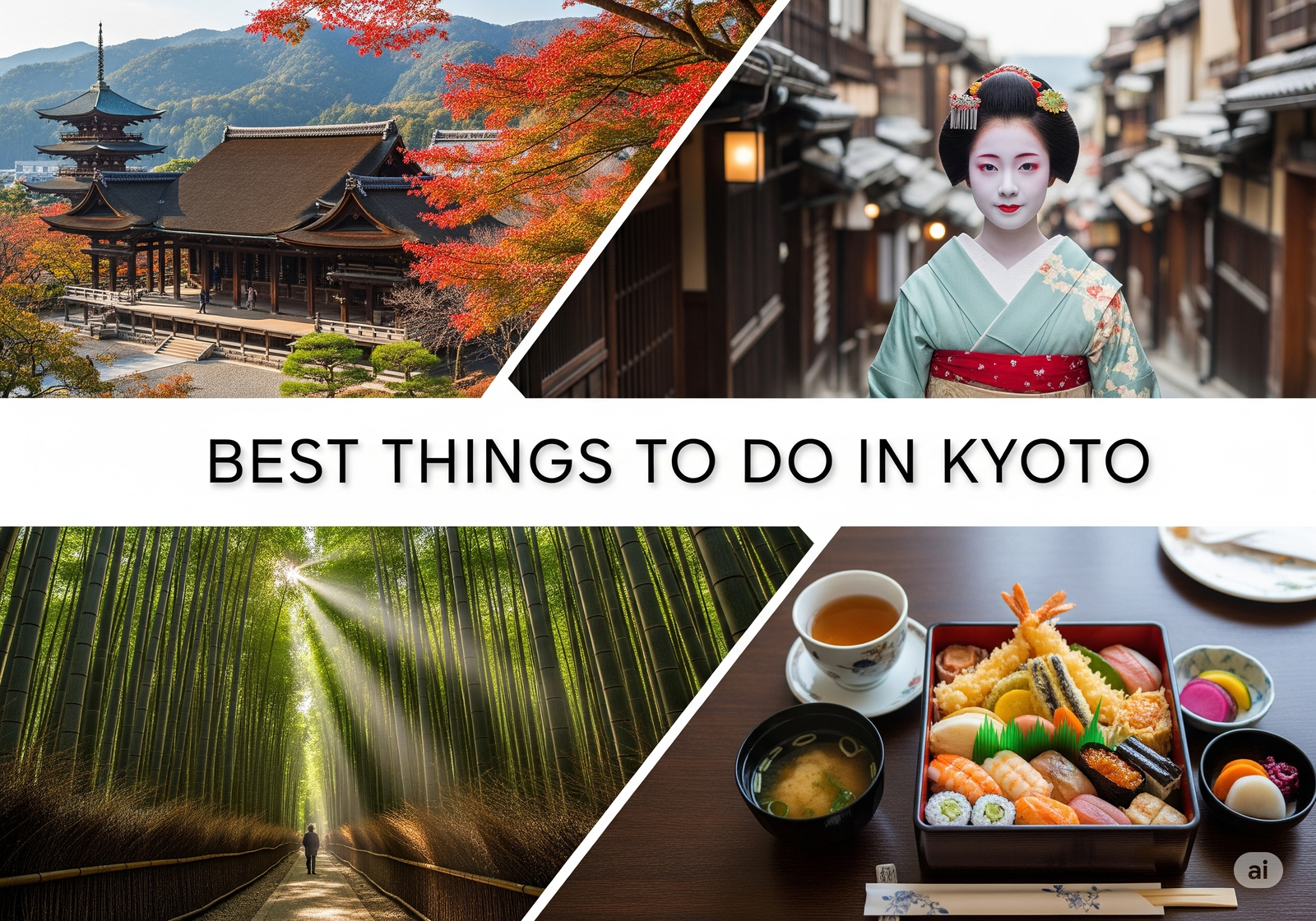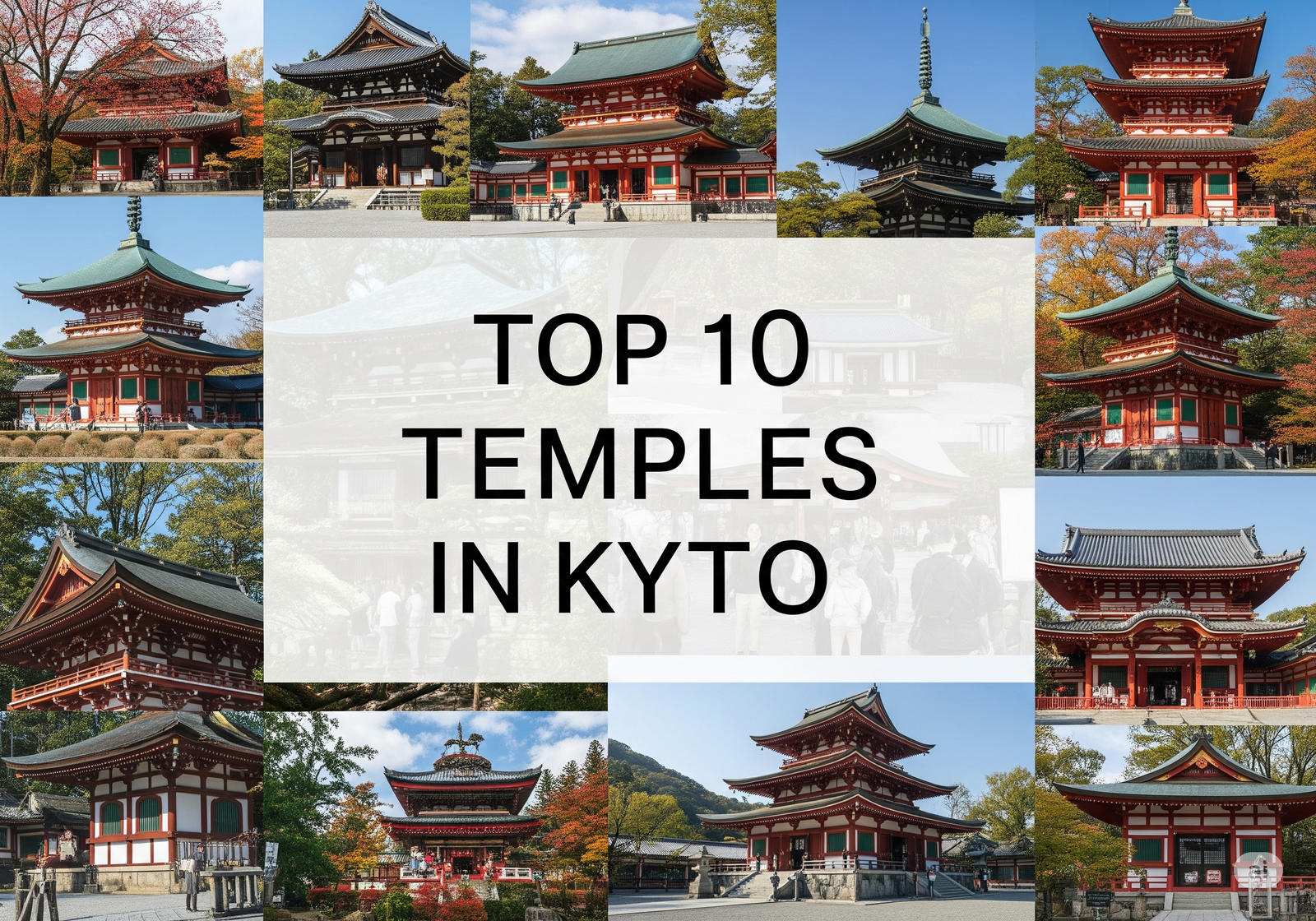Table of Contents
- Introduction to Kyoto
- Best Time to Visit
- How to Get to Kyoto
- Getting Around Kyoto
- Where to Stay in Kyoto
- Top Attractions in Kyoto
- Temples & Shrines
- Cultural Experiences
- Nature & Gardens
- Hidden Gems Off the Beaten Path
- Kyoto Food Guide
- Kyoto Travel Itinerary Ideas
- Day Trips from Kyoto
- Kyoto Travel Tips
1. Introduction to Kyoto
Kyoto (京都), once the imperial capital of Japan for over a thousand years (794–1868), remains one of the country’s most culturally rich and historically significant cities. Unlike the futuristic skyline of Tokyo or the vibrant hustle of Osaka, Kyoto is a serene refuge where tradition breathes through every wooden gate, every Zen garden, and every kimono-clad geisha who disappears around a lantern-lit alley.
With 17 UNESCO World Heritage Sites, more than 1,600 Buddhist temples and 400 Shinto shrines, Kyoto is a spiritual treasure trove. But it’s more than just history. Kyoto is also a city of living culture—whether it’s savoring seasonal kaiseki cuisine, experiencing a formal tea ceremony in a machiya townhouse, or taking part in centuries-old festivals like Gion Matsuri.
Why do travelers fall in love with Kyoto?
- It’s where cherry blossoms frame ancient pagodas.
- It’s where you can walk in the footsteps of samurai, monks, and emperors.
- It’s where time slows down, and beauty is found in simplicity.
For those looking to explore Japan beyond the neon lights, Kyoto is an essential pilgrimage.
2. Best Time to Visit Kyoto
Each season in Kyoto transforms the city into a new canvas of color, sound, and experience.
🌸 Spring (March–May)
- Cherry blossoms blanket the city from late March to early April.
- Streets like the Philosopher’s Path, Maruyama Park, and Heian Shrine gardens burst with hanami revelers and photographers.
- Weather is mild (12–20°C) and fresh.
☀️ Summer (June–August)
- June is humid and rainy, but July and August host vibrant events.
- Gion Matsuri, Kyoto’s largest festival, features parades, night markets, and traditional performances.
- Escape to Kurama, Kibune, or Arashiyama for cooler mountain air.
🍁 Autumn (October–November)
- Leaves change color dramatically, especially at Tofuku-ji, Eikando, and Kodaiji.
- Crisp air (10–18°C) makes temple-hopping ideal.
- Less crowded than spring but just as photogenic.
❄️ Winter (December–February)
- Quiet, spiritual atmosphere with lower prices.
- Snow-draped temples like Kinkaku-ji are magical in the early morning.
- Seasonal dishes like yudofu warm the soul.
3. How to Get to Kyoto
✈️ From Airports
Kansai International Airport (KIX):
- Haruka Express: 75 mins direct to Kyoto Station (covered by JR Pass).
- Limousine Bus: ~90 mins; slower but more luggage-friendly.
Itami Airport (Domestic):
- Take the Limousine Bus or a taxi (~60 mins).
🚄 From Tokyo or Osaka
Shinkansen (Bullet Train):
- Nozomi: Fastest (2 hr 20 min); not JR Pass eligible.
- Hikari: Slightly slower (2 hr 45 min); JR Pass OK.
- Kodama: Budget option; ~4 hr.
🚌 By Bus (Budget)
- Willer Express, JR Bus, and other services offer overnight or day buses.
- Duration: 8–9 hours.
- Prices: ¥3,000–¥6,000.
4. Getting Around Kyoto
Kyoto has a compact yet well-organized transport system. Here’s how to navigate like a local:
🚌 City Bus (Main Temple Access)
- Flat fare: ¥230 per ride or ¥700 for day pass.
- Buses reach areas like Gion, Kinkaku-ji, and Arashiyama.
🚇 Subway
- Two lines: Karasuma (N/S) and Tozai (E/W).
- Great for reaching Kyoto Station, Nishiki Market, or downtown.
🚲 Bicycle
- Rent a bike from shops near Kyoto Station or Gion.
- Ideal for scenic exploration through Higashiyama, Gion, and Kamogawa River.
🚶 On Foot
- Kyoto’s neighborhoods are walkable and full of hidden corners.
5. Where to Stay in Kyoto
🏯 Gion & Higashiyama
- For Traditional Kyoto:
Stay in a machiya townhouse or ryokan with tatami mats and paper sliding doors.
Great for geisha sightings and tea ceremonies.
🏢 Kyoto Station Area
- For Convenience:
Excellent train, subway, and bus connections.
Perfect for day trips and late arrivals.
🌲 Arashiyama
- For Nature & Peace:
Bamboo groves, temples, and riverside walks.
Consider staying at Hoshinoya Kyoto for a luxury riverside ryokan.
💰 Budget Options
- Guesthouses & Hostels in Downtown:
Areas like Nishiki Market, Karasuma, and Gojo offer great access with affordable rates.
6. Top Attractions in Kyoto
🛕 Temples & Shrines
- Fushimi Inari Taisha:
- 10,000+ red torii gates through a sacred mountain trail.
- Go early morning or sunset to avoid crowds. - Kinkaku-ji (Golden Pavilion):
- Gold leaf-covered Zen temple reflecting over a pond.
- Best in winter or autumn. - Kiyomizu-dera:
- Grand wooden stage with views over sakura or momiji.
- Includes Otowa Waterfall with “wishes” stream. - Ginkaku-ji (Silver Pavilion):
- Simpler aesthetics; home to a raked sand zen garden.
- Connects to Philosopher’s Path. - Ryoan-ji:
- Abstract rock garden with deep Zen symbolism.
Top 10 Temples in Kyoto: A Journey Through Japan’s Spiritual Heart
🎎 Cultural Experiences
- Kimono Rental & Walks in Gion:
- Rentals start at ¥3,000.
- Best for photo sessions near Yasaka Shrine. - Tea Ceremony (Chado):
- Book at teahouses in Uji or Gion.
- Try En Tea House or Camellia. - Geisha or Maiko Performance:
- Gion Corner offers daily cultural shows.
- Exclusive dinners with geisha via tour operators. - Zazen Meditation:
- Try it at Shunko-in Temple or Daitoku-ji.
Best Things To Do in Kyoto: Cultural Gems, Hidden Corners & Unforgettable Experiences
🌳 Nature & Gardens
- Arashiyama Bamboo Grove:
- A surreal walk through towering bamboo stalks.
- Nearby: Tenryu-ji Zen garden & Monkey Park Iwatayama. - Philosopher’s Path:
- Cherry blossom-lined canal walk between Ginkaku-ji and Nanzen-ji. - Tofuku-ji Temple Garden:
- Incredible autumn views from its Tsutenkyo Bridge.
7. Hidden Gems Off the Beaten Path
- Otagi Nenbutsu-ji (Arashiyama):
- 1,200 humorous stone statues tucked into the hills. - Kurama to Kibune Hike:
- Serene 2–3 hour trail with temples, forests, and a riverside lunch at the end. - Kyoto International Manga Museum:
- Thousands of manga volumes, historic displays, and cosplay events. - Kyoto Gyoen National Garden (Imperial Palace):
- Free-entry park with rare tranquility in the city center.
8. Kyoto Food Guide
🍽️ Must-Try Kyoto Foods
- Kaiseki Ryori:
- A seasonal multi-course meal; elegant and artistic. - Yudofu:
- Temple-origin tofu dish served hot in broth. - Saba-zushi (Mackerel Sushi):
- Kyoto’s answer to sushi without fresh sea fish. - Matcha Everything:
- Ice cream, cake, tea — Uji matcha is world-class.
🍜 Where to Eat
- Nishiki Market:
- Try tsukemono (pickles), tamagoyaki, or soy milk donuts. - Pontocho Alley:
- Romantic lantern-lit alley along the Kamogawa River. - Kyoto Ramen Koji (Kyoto Station):
- Ramen street featuring styles from all over Japan.
9. Kyoto Travel Itinerary Ideas
🧳 3-Day Itinerary
Day 1:
- Gion Walk
- Yasaka Shrine
- Kiyomizu-dera
- Nishiki Market (evening)
Day 2:
- Arashiyama Bamboo Grove
- Tenryu-ji Temple
- Monkey Park
- Togetsukyo Bridge
Day 3:
- Fushimi Inari
- Tofuku-ji
- Shopping near Kyoto Station
🧘 5-Day Itinerary
Add:
- Nijo Castle
- Kyoto Imperial Palace
- Kurama-Kibune Hike
- Uji Matcha Town
10. Day Trips from Kyoto
🦌 Nara
- Giant Buddha at Todai-ji
- Nara Deer Park
- 45 mins via JR Nara Line
🍵 Uji
- Uji Byodoin Temple
- Tea Ceremonies & Museums
- 20 mins by train
🎢 Osaka
- Food (takoyaki, okonomiyaki)
- Dotonbori & Universal Studios
- 30–60 mins via JR or Hankyu
🏯 Himeji
- Himeji Castle – Japan’s most beautiful feudal castle
- 1.5 hr via JR line
11. Kyoto Travel Tips
- Language: Learn basic Japanese greetings. English is spoken in tourist areas.
- Cash Preferred: Many small businesses don’t accept cards. Use ATMs at 7-Eleven or post offices.
- Temple Etiquette: Remove shoes, don’t photograph inner altars unless allowed.
- Quiet Hours: Avoid talking on the phone on public transport.
- Booking Ahead: Reserve accommodation and popular restaurants early in high season.
Conclusion
Kyoto is more than a city — it’s a window into Japan’s soul. Whether you’re walking through ancient torii gates, sipping matcha in a tranquil garden, or catching the quiet elegance of a geisha slipping past a paper lantern-lit alley, Kyoto invites you to slow down and savor every moment.
This guide only scratches the surface, but it’s a perfect place to start your Kyoto adventure.














Leave a Reply